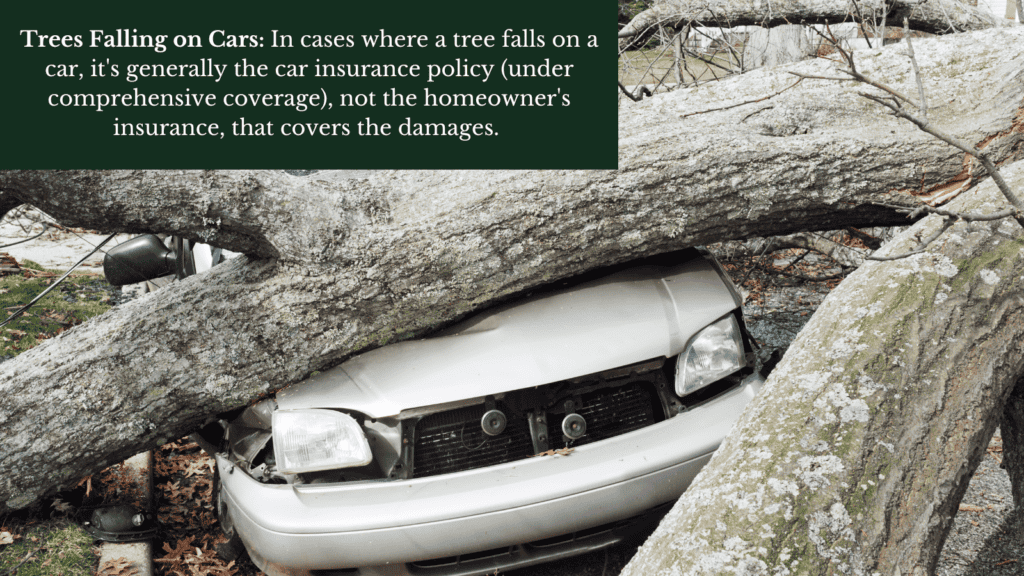Navigating the complexities of homeowners insurance is an essential aspect of property ownership and management. Trees add beauty and value to our properties, but they can also become liabilities when they fall, potentially causing damage to structures and necessitating costly removal. Understanding how homeowners insurance policies respond to such situations is crucial.
Fallen trees encompass a range of scenarios, each with its own set of implications for property owners. Such incidents not only pose questions about property damage on personal or neighboring lands but also bring into focus the coverage specifics of standard insurance policies. There are several factors that determine whether damage is generally included or excluded in homeowners insurance policies, and understanding these will help effectively manage tree-related damages and the associated insurance processes.

What is Homeowners Insurance?
Homeowners insurance is a form of property insurance that covers losses and damages to an individual’s house and assets in the home. It provides financial protection against disasters, theft, and accidents inside the home or on the property. Typically, a standard homeowners insurance policy includes coverage for the structure of the home, personal belongings, liability protection, and additional living expenses if the home is temporarily uninhabitable. The extent of coverage, however, can vary based on the individual policy and the insurance provider. This insurance is often a requirement by mortgage lenders and serves as a crucial safety net for homeowners, safeguarding their investment and providing peace of mind.
Is Tree Removal Covered Under Homeowners Insurance Policies?
The coverage of tree removal under homeowners insurance policies can vary, but typically, it is covered under certain conditions. Most standard policies provide coverage for tree removal if the tree falls due to natural causes like storms, lightning, wind, or snow and ice accumulation. This coverage generally includes the cost of removing the tree if it falls on the insured structure – such as your home, garage, or fence – and causes damage.
However, there are limitations and exclusions. If the tree falls due to negligence, like failing to maintain a diseased or dying tree, the insurance might not cover the removal costs. Additionally, if a tree falls without damaging an insured structure (like falling in your yard without hitting your house), many policies do not cover the cost of removal. The specifics can vary based on your particular insurance policy and provider, so it’s important to review your policy details or consult with your insurance agent for clear information on coverage related to tree removal.
When are Tree Removal Costs and Damages Covered?
Tree removal costs and damages are typically covered under homeowners insurance policies in the following scenarios:
- Natural Disasters and Weather-Related Events: If a tree falls due to natural causes like severe weather (storms, hurricanes, lightning, strong winds), heavy snow, or ice accumulation, insurance policies generally cover the removal costs and damages. These are considered uncontrollable events, often classified as ‘Acts of God.’
- Damage to Insured Structures: Coverage is provided when the fallen tree damages a covered structure on your property, such as your home, garage, shed, or fence. In these cases, insurance will often cover the costs of both removing the tree and repairing the damage caused by the fall.
- Neighbor’s Property: If your tree falls on a neighbor’s property due to natural causes and causes damage, it is usually the neighbor’s insurance policy that covers the damage and removal costs. Conversely, if a neighbor’s tree falls on your property and causes damage, your insurance would typically cover the costs.
- Shared Responsibility Situations: In cases where a tree falls on a boundary line between properties or affects shared structures (like a fence), insurance policies might split the cost of removal and repairs between the two parties’ policies.

What Situations Exclude Coverage for Tree Removal Costs and Damages in Homeowners Insurance?
Tree removal costs and related damages are typically not covered by homeowners insurance in the following scenarios:
- Negligence and Poor Maintenance: If a tree falls due to negligence, such as not addressing known diseases, decay, or instability, insurance usually won’t cover the costs. This applies when the homeowner has ignored necessary maintenance, including pruning or addressing pest infestations.
- Dead or Dying Trees: If a tree was already dead or in a visibly decaying state before falling, insurance companies often consider it a maintenance issue and may deny coverage for any resulting damage or removal costs.
- No Damage to Insured Structures: If a tree falls without causing damage to insured structures (e.g., falling in the middle of the yard, away from the house or other structures), many insurance policies do not cover the cost of its removal.
- Trees Falling on Cars: In cases where a tree falls on a car, it’s generally the car insurance policy (under comprehensive coverage), not the homeowner’s insurance, that covers the damages.
- Acts Within the Homeowner’s Control: Events or actions within the homeowner’s control that lead to a tree’s fall (such as cutting down a tree improperly) may not be covered.
How Does Homeowners Insurance Handle Tree Removal and Property Damage?
When a tree falls and causes property damage, homeowners insurance typically operates through a specific claims process:
- Assessment of the Incident: After a tree falls, the homeowner should immediately document the incident. This includes tree inspection and taking photographs of the fallen tree, the damage it caused, and any conditions that led to the tree’s fall, such as storm damage.
- Filing a Claim: The homeowner then files a claim with their insurance provider. The claim should detail the incident, the damage caused, and any other relevant information, such as a police or fire department report if applicable.
- Insurance Adjuster’s Inspection: The insurance company sends an adjuster to inspect the property and assess the damage. The adjuster evaluates whether the fallen tree and the resultant damage are covered under the policy and determines the extent of the insurance company’s liability.
- Determination of Coverage: The adjuster considers several factors, such as the cause of the tree’s fall (natural event or negligence), the type of damage (to a structure or just in the yard), and policy specifics like coverage limits and deductibles.
- Approval and Reimbursement: If the claim is approved, the insurance company provides financial reimbursement for the damages and tree removal costs, subject to the policy’s terms. The amount can vary depending on the policy’s coverage limits and the deductible amount.
- Repair and Removal Work: Once the claim is approved, the homeowner can proceed with the tree removal and repairs. Homeowners can either use contractors suggested by the insurance company or choose their own, depending on the policy terms.
- Settlement and Closure of Claim: After the work is completed and all costs are accounted for, the insurance company settles the claim. If there are disputes or disagreements over coverage or costs, these are typically resolved through further discussions or negotiations between the homeowner and the insurance company.
This process can vary slightly depending on the insurance provider and the specific terms of the homeowner’s policy.

